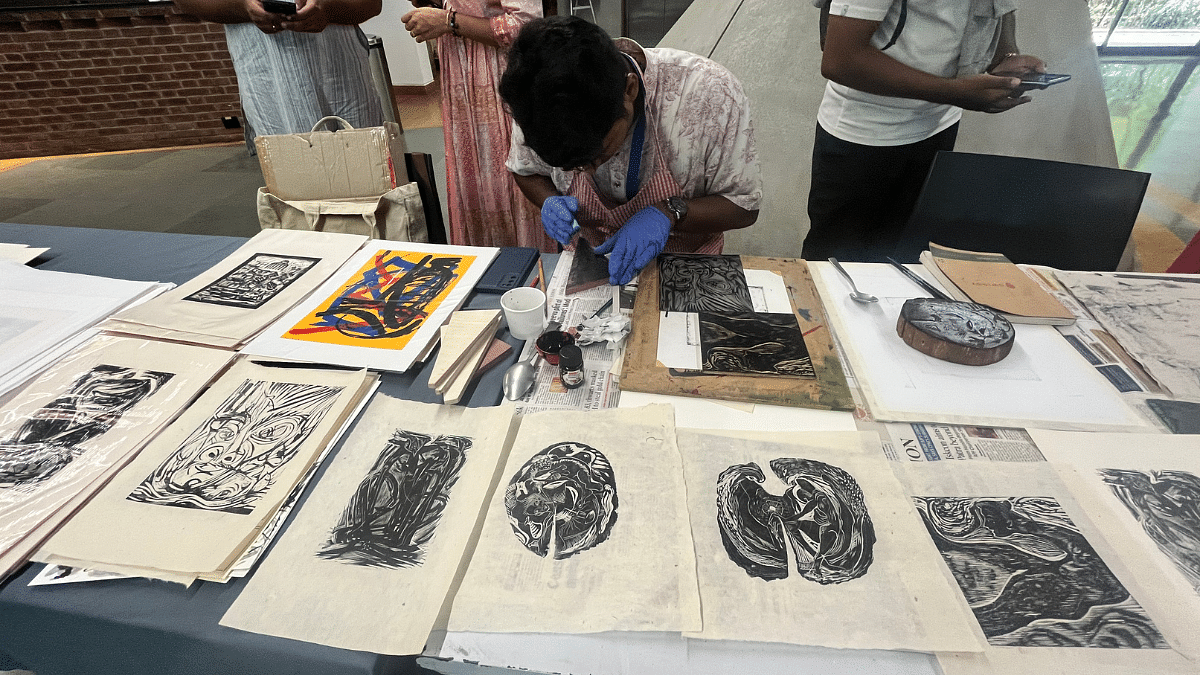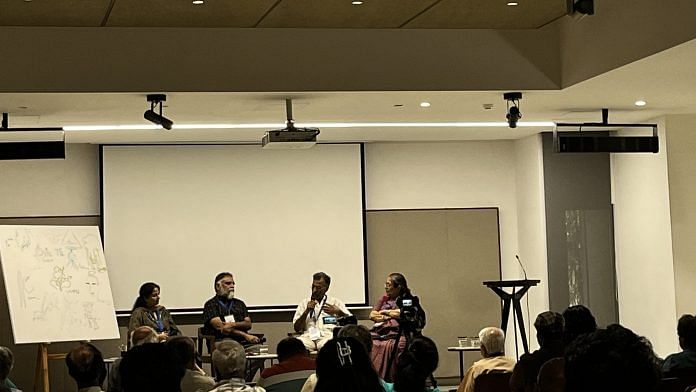Bengaluru: After a decade of art-in-the-park movement, Bengaluru artists are now at a crossroads. They managed to bring art out of the white cube of galleries, but now they want the crowds too. If people are flocking to Indian Premier League matches, theatre and music concerts, why not engage with art in bigger numbers?
This question consumed artists and art lovers who flocked to the Bangalore International Centre recently. The event was the 75th session of the Art Park – an initiative taken up by Bengaluru artists. It was an effort to celebrate the arts and also reclaim public spaces — not unlike the Speakers’ Corner at London’s Hyde Park and the art exhibitions at New York’s Central Park. Founded in 2014 by modern and contemporary art painter SG Vasudev, the platinum jubilee session was celebrated by showcasing video films of previous Art Park events, a panel discussion, poetry, music and art performances, apart from an exhibition of fine arts works.
“I think it is our responsibility to build community and audience. [We need to] connect with them, talk to them. Otherwise, we are speaking to ourselves,” said art historian Suresh Jayaram.
He noted that the event has to go beyond its usual “familiar faces”.
Artists attending the event said that visual arts must build more communities and find ways to attract other forms to make art more vibrant and engaging to the general public.
The panellists, actress Arundhati Nag, painter Jayakumar G, art curator Nalini Malaviya, and author Suresh Jayaram engaged in the one-hour-long talk in the hall packed with nearly 70 people. The conversation revolved around expanding Art Park’s footprint and bringing an interdisciplinary approach to visual arts.
They also took stock of how they de-eliticised art in the past decade — a milestone moment.
“It’s passersby who are coming by into the Art Park and having an experience or just looking at somebody drawing or buying a book. I think that is more important,” he said.

While the discussion raged on inside the hall, the foyer outside brimmed with 22 artists’ works on tables, easels, and against glass panels. Contemporary and abstract themes dominated the artworks; watercolour paintings showed still subjects like vases or an emotive heart-shaped balloon tied to a piece of brick. A doodle portrayed a phone splashed in water, with various social media icons coming out of it. One artist displayed small postcard-sized paintings featuring a series of snow-clad mountains. Visitors got a chance to not just buy art pieces but also witness painters and artists creating art.

Akshay Bhat was among the artists to present his work at the event. With an apron wrapped around his waist, he sat sculpting designs on a piece of wood. The 32-year-old was showing the audience how the black and white paintings on the table came into existence.

“I’ve participated in previous Art Park events. It’s a helpful tool and necessary for the development of art today. For me, the event brings a lot of enthusiasm and encouragement and art lovers can come together,” he said.
Visual arts lacking audience
Panellists at Art Park didn’t shy away from having difficult conversations and acknowledged that visual arts fare worse than other forms of arts.
“Somehow, the visual arts tends to lack audiences,” said Bengaluru-based curator and writer Nalini Malaviya. “When there is a theatre performance, there’s a play, music…a lot of people buying tickets. We are very jealous of that,” she said.
Arundhati Nag suggested a thematic approach to attract audience in future and help them understand art better. It would help, she said, if writers, philosophers, theatre personalities delivered speeches that enabled “some kind of osmosis” between theme, discipline, and the visual arts.
Malaviya, too, vouched for an interdisciplinary approach. “Maybe if theatres would somehow promote visual arts like you (Nag) are doing, I think then that synergy would bring in more audiences and it would help everyone,” she said.
Speaking to ThePrint after the event, Art Park president Bhagya Ajaikumar said the relatively bigger scale of the 75th session was to “promote the initiative”. Now, they are trying to reach more people by planning sessions in newer areas of Bengaluru.
But fund crunch remains a major challenge, which, Ajaikumar said, “depends on donations”. Committee members take turns to hold the sessions. Every month, two Art Park committee members curate a session where they invite 20-25 artists.
“When we curate, we have a mix of senior and emerging artists,” she explained. The goal is to provide a platform to newer artists and bring fine arts and visual artists to more egalitarian spaces. “Not everyone can go and afford artwork at a gallery,” Ajaikumar said.
Back at the session, Malaviya spoke about how Bengaluru’s cultural landscape has changed along with its urban environment. The other imminent change has been the way information is generated, disseminated, and consumed.
“So, it means that the way we consume art and culture has also changed over the last decade,” she said, stressing that it makes Art Park sessions even more important.
And locations and venues were not approached as watertight spaces. “It’s disseminating the idea, essentially of the Art Park, of having a community activity, which can be done anywhere,” Malaviya said.
(Edited by Humra Laeeq)




Art is unaffordable for the commoner.